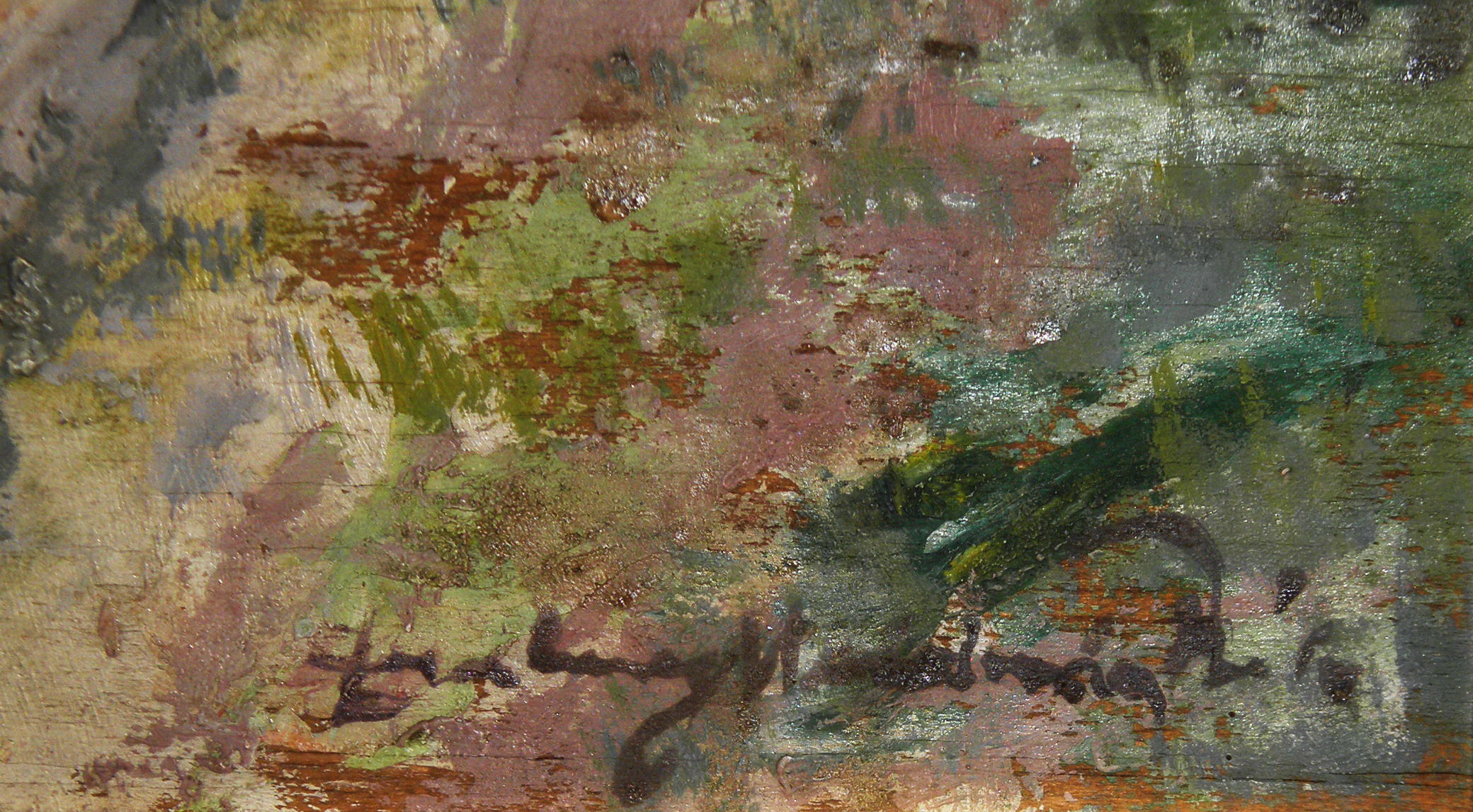 |
|
Zombory-Moldován Bélafestőművész(Munkács, 1885. ápr. 20. – Balatonfüred, 1967. aug. 20.). A Képzőművészeti Főiskolán Hegedűs László, Székely Bertalan és Ferenczy Károly voltak mesterei, 1905-ben a nagybányai Szabadiskolában is tanult. Tanulmányutakat tett Németországban, Olaszországban, Franciaországban és Belgiumban. 1909-től a Székesfővárosi Iparrajziskola tanára, 1935-től 1946-ig igazgatója volt. Eleinte főleg ifjúsági könyvek illusztrálásával foglalkozott. Az I. világháborúban a galíciai harctéren súlyosan megsebesült. Felépülése után továbbszolgálóként az akkori Honvédelmi Minisztérium kötelékébe lépett, itt készültek ma is számon tartott plakátjai. A 20-as évektől áttért a portréfestészetre. Az 50-es évektől kezdve foglalkozott tájképfestészettel, csendéletfestéssel és rézkarcokat is készített. Hangulatos akvarelljei a Balatonról, a Balaton-felvidék tájainak műemlékeiről főként a II. világháború után készültek. Az év egy részét családjával balatonfüredi nyaralójában töltötte. Tagja volt a Peremartoni Nagy Sándor által, 1926-ban alapított Balatoni Művészkolónia Egyesületnek. 1933-ig Moldován Béla néven alkotott és szignálta munkáit. Ekkor (hogy megkülönböztesse magát Moldován István kolozsvári születésű festőművésztől) fölvette édesanyja leánykori nevét, aki a tarczali Zombory-családból származott, és azontúl Zombory-Moldován Bélaként jegyezte alkotásait. Híresebb portréi: Glattfelder Gyula csanádi püspök, Thoroczkai-Wigand Ede műépítész, Bory Jenő szobrászművész, Pásztor János szobrászművész, Siklódi Lőrinc szobrászművész, Lux Elekné portréja, valamint az első sztahanovista mozdonyvezető portréja. Híresebb festményei: Keresztrakók, Dudis Tomi. Több festményét Hollandiában és Angliában vásárolták meg. Freskói: Szent István-oltárkép (Bp., Ciszterciták temploma), Szent Gellért vértanúsága (Bp., Patrona Hungariae Gimn.). 1913–1947 között rendszeresen vett részt kiállításokon. Alapító tagja és ügyvezető igazgatója volt a Magyar Arcképfestők Társaságának, tagja az Országos Magyar Képzőművészeti Társulatnak, főtitkára a Magyar Képzőművészeti Egyesületnek. A Fészek Klub alapító tagja. Műveiért számos kitüntetést kapott (Tolnai-díj, 1919; Barcelona ezüstérem, 1929; Rökk-díj, 1932; Balló-díj, 1935; Ráth-díj, 1936).
Forrás:
|
Béla Zombory-MoldovánHungarian painter(Munkács, April 20, 1985 – Balatonfüred, August 20, 1967) Excerpts from the Introduction to „The budding young Hungarian artist Béla Zombory-Moldován was on holiday when the First World War broke out in July 1914. Called up by the army, he soon found himself hundreds of miles away, advancing on Russian lines. (…) Badly wounded, he returned to normal life. (...) In 1916 he returned to Budapest to work in the war ministry’s information office as a designer: here he created, among other things notable designs for posters for the war effort and to advertise exhibitions associated with it. He was also responsible for designing the coronation ceremony of the hapless Karl in December 1916. After the war, he returned teaching at the Budapest School of Applied Arts, as he had done from 1909 to 1914: he became the principal in 1935 and an adviser to the education minister, for which he was honored. These were also years of recognition and success for him as a painter. His work (invariably realistic and „painterly” in style) won numerous prizes and was shown at the Barcelona International Exposition of 1929. He enjoyed particular success as a portraitist ... Plain „Béla Moldován” until 1933, in that year he officially took his mother’s family name as a prefix to his own. She was from an old titled family (Zombory de Tarczal) and had died when he was ten. He was a lifelong conservative by temperament, a lover of old and well worn things, and a determined disparager of modernist tendencies in art; but he disliked the increasingly rightward drift under the Horthy regime from the mid-1930s, and spurned an invitation to join the so-called Order of Gallantry (Vitézi Rend) established by the regime as elite guardians of the nationalist flame. Following the German military occupation of Hungary in March 1944, at great personal risk, he sheltered a Jewish family from deportation and murder. (…) (He was characteristically bemused by the unannounced visit, shortly after the war, of a deputation from the local synagogue who insisted on blessing him as a “righteous Gentile”.) The establishment of a Moscow-sponsored Communist regime in Hungary after World War II was a personal as well as a national catastrophe. Béla was interrogated by the secret police, the dreaded ÁVO, at their headquarters at 60 Andrássy Avenue. In 1946, caught up in a purge of “right-wing elements” from public service in which some sixty thousand officials were removed from their posts, he was dismissed from the School of Applied Arts. Unable to sell his work and excluded from the state-approved artists’ organizations (…) he withdrew into virtual seclusion, spending long periods alone in the little thatched summer house he had designed in the 1930s at Balatonfüred in western Hungary. There, he occupied himself with making paintings, watercolours, and etchings of the region’s open landscapes and the shores of Lake Balaton, getting about on an ancient black bycicle. These are probably his finest body of work: Restrained, modest in scale, and filled with a quiet, calm luminosity, they express his love of the land. (...) Béla Zombory-Moldován died at Balatonfüred on August 20, 1967.” |

